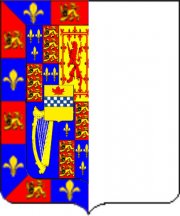The Arms of Dr Claire Boudreau
by Brian de Fitz-James; 29, December, 2008
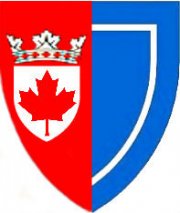
The personal Arms of Dr Claire Boudreau, on the sinister side of the shield, impaled with the Arms of Office of the Chief Herald of Canada.
Lady Heralds
On December 12th of 2008, Dr Claire Boudreau, the Chief Herald of Canada, announced the appointment of Karine Constantineau to the offices of Saguenay Herald and Assistant Registrar of the Canadian Heraldic Authority; Miramichi Herald since 2003, Ms Constantineau was appointed following a national competition process. Five of the six most senior Officers of Arms in Canada are ladies: the Head of the Canadian Heraldic Authority, Her Excellency the Right Honourable Michaëlle Jean; the Herald Chancellor, Sheila-Marie Cook; the Deputy Herald Chancellor, Emmanuelle Sajous; the Chief Herald of Canada; and the new Saguenay Herald.
Fraser Herald, the Principal Artist of the Authority, has been Cathy Bursey-Sabourin since 1989, and her Assistant Artist is Catherine Fitzpatrick, Coppermine Herald since 2003. Canada also has a lady Officer of Arms Extraordinary: Dr Helen Mussallem CC has been Capilano Herald Extraordinary since 2006. Illustrations of the Arms and Badges of Office, and of the personal Armorial Bearings,
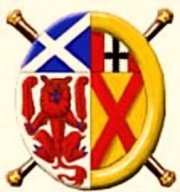
The Armorial Bearings of Elizabeth Ann Roads, née Bruce, Carrick Pursuivant, impale her personal Arms with her Arms of Office as Lyon Clerk. Note that the bordure Or of her Arms is dimidiated at the palar line: I return to the subject further in this note.
Canada leads the world in the number of lady heralds, but we were not the first country to have rejoiced in one. Elizabeth Ann Roads MVO joined the staff of Scotland's Court of the Lord Lyon King of Arms in 1975, and was named Lyon Clerk and Keeper of the Records in 1986. She was appointed Linlithgow Pursuivant Extraordinary in 1987, and was the first lady to be named a royal Officer of Arms. She represented the Lord Lyon in Canada in the discussions that led to the establishment of the Canadian Heraldic Authority, and in 1992 was appointed Carrick Pursuivant of Arms in Ordinary. Nor was Canada the first country to have a lady Chief Herald; Patricia Donlon was Chief Herald of Ireland from 1995 to 1997.

Heraldic Ex Libris of Elizabeth Ann Roads
by Gordon Macpherson
The Chief Herald of Canada
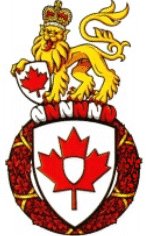
The Arms and Crest of the Canadian Heraldic Authority
Dr Claire Boudreau PhD FRHSC AIH is a genealogist and historian. In 1997 she was appointed to the offices of Saguenay Herald and Assistant Registar of the Canadian Heraldic Authority; she was Saint-Laurent Herald and Registrar from 2000 to 2007, and has been the principal designer and administrator of the Authority’s online Public Register of Arms, Flags and Badges of Canada, first launched in July of 2005. She was Deputy Chief Herald from 2005 until June 26th, 2007, when she succeeded Robert Watt LVO as the second Chief Herald of Canada. An internationally-recognized scholar in heraldic studies and author of many articles and publications, she is a Fellow of the Royal Heraldry Society of Canada and Academician of the Académie Internationale d'Héraldique.
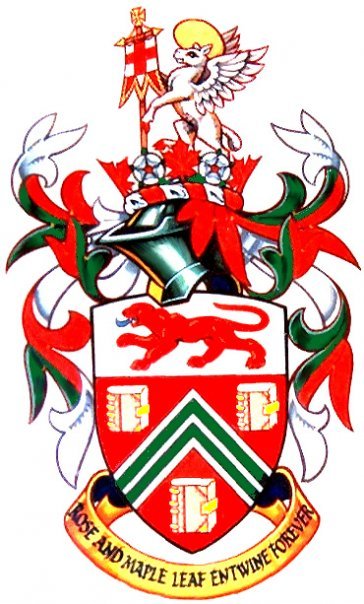
The Armorial Bearings of Robert Watt, Chief Herald of Canada from 1988 to 2007
by Hans Birk
The Chief Herald of Canada directs the operations of the Canadian Heraldic Authority and makes the Grants of Arms, with the exception of certain grants made directly by Viceregal Warrent. The tinctures of the Chief Herald's Arms of Office are the official colours of Canada: Gules and Argent. In the centre is a small shield, emblematic of heraldry itself, bearing a maple leaf. The Office of Chief Herald is a counterpart to the Kings of Arms in the Crown's older heraldic authorities, and so its inner shield is ensigned with a maple leaf coronet Argent, the rim of which is set with jewels Gules. The crossed Batons of Office behind the shield feature these same Arms, and a decorative band of Azure, representing the great rivers of Canada, charged with maple leaves Argent.
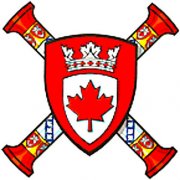
The Arms of Office of the Chief Herald of Canada
Dr Boudreau's Arms were granted by the Canadian Heraldic Authority in 2004. The almost starkly simple blazon is Azure an orle Argent; the Crest is a panther rampant Azure incensed Proper. Like almost all Canadian grants to ladies, the Arms are displayed on a shield, rather than a lozenge or oval; all Canadian ladies may be granted Crests and use heraldic helmets, but the use of these latter is optional for both gentlemen and ladies, and in this case the petitioner chose not to have a helmet painted on the exemplification of her Grant.

The Armorial Bearings of Dr Claire Boudreau, Chief Herald of Canada since 2007
The personal Badge, granted at the same time as the Arms and Crest, is blazoned as a panther’s face Azure incensed Proper jessant-de-lis Argent.
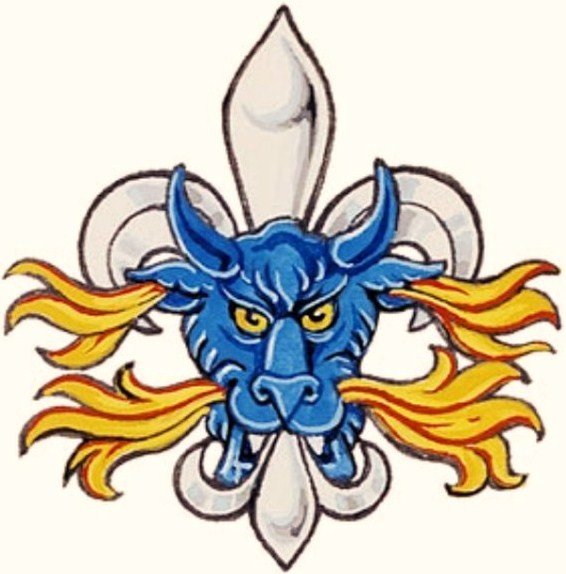
The personal Badge of Dr Claire Boudreau
Simple Shields of Uncharged Fields
As simple as this Coat of Arms is, Dr Boudreau had originally petitioned, according to a message posted by Assiniboine Herald to the Scots Heraldry website, for Arms of the ultimate simplicity: a plain shield Azure. The Chief Herald of the time decided otherwise; but, with the orle, the Arms do show what may be viewed as a plain shield Azure fimbriated Argent on a plain shield Azure.
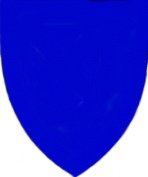
Azure
A plain red quartering known as the Blut Fahne or Regalien quarter is to be found in the full quartered Coat of some German princes, and is indicative of royal perogatives. Coats of Arms of such simplicity are naturally rare. In his captions to the illustrations below, Sir Iain Moncreiffe of that Ilk identifies eleven uncharged Coats, assigned to the following armigers:
Gules (red) to d'Albret, Azure (blue) to Maienthal, Sable (black) to Gournay, Vert (green) to Pupellin, and Purpure (purple) to Aubert;
Or (gold or yellow) to de Menezes and Argent (silver or white) to Zgraia;
Ermine (Argent with ermine spots Sable) to the Duke of Brittany, Contre-Ermine (Sable with ermine spots Argent) to de Rousselet, Erminois (Or with ermine spots Sable) to van der Eze, and Vair (stylized squirrel skins of alternating Azure and Argent, representing the backs and bellies of these little creatures) to zu Pappenheim.

The five principal heraldic colours

The two heraldic metals

Four of the heraldic furs
These drawings by Don Pottinger, from his and Sir Iain Moncreiffe's book Simple Heraldry Cheerfully Illustrated, can also be found in my earlier note of the same name, along with about one hundred other drawings by the same artist; I am constantly enriching my earlier notes.
I doubt whether the Arms attributed to Maienthal are still in use; identical Coats of Arms, and especially simple ones, may be found within the jurisdictions of more than one heraldic authority, but good heraldry continues to respect the Arms granted in other countries and in other centuries, even if there are no longer lineal armigers to lay claim to historic Arms, and this is most probably the reason why Chief Herald Robert Watt was disinclined to grant Dr Boudreau a plain Coat Azure.
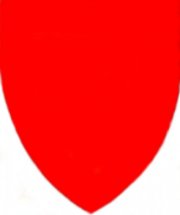
Gules: the Regalien Coat of some Germanic Sovereigns; in heraldry few things are more distinguished than utter simplicity.
Impalement and Dimidiation!
Two Coat of Arms are often impaled together, including the Arms of a married couple and the Arms of certain officials who may join their personal Arms with the Arms of their office, or with the Arms of the corporate body of which they are head. The Arms of Office of both the Herald Chancellor and the Deputy Herald Chancellor of Canada are thusly impaled with their personal Arms, and it is customary for Canadian bishops to impale the Arms of their diocese with their personal Arms.
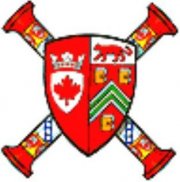
The personal Arms of Robert Watt impaled with his Arms of Office as Chief Herald of Canada; since 2007 Mr Watt has held the title of Rideau Herald Extraordinary
In impaling a Coat of Arms which is surrounded by a bordure, the bordure is not continued down the centre between the two Coats, but stops short at the palar line; the same rule is often said to apply to the tressure. According to Arthur Fox-Davies' authoritative A Complete Guide to Heraldry, this rule does not apply to the orle. I have not yet seen an official exemplification of Dr Boudreau's Arms impaled with her Arms of Office, but I hope that she will ignore this "rule". Mr Fox-Davies himself, immediately after laying down the law in respect of orles impaled, wistfully remarks: "The curious fact, however, remains that this rule as to the dimidiation of the bordure in cases of impalement is often found to be ignored in ancient seals and other examples."
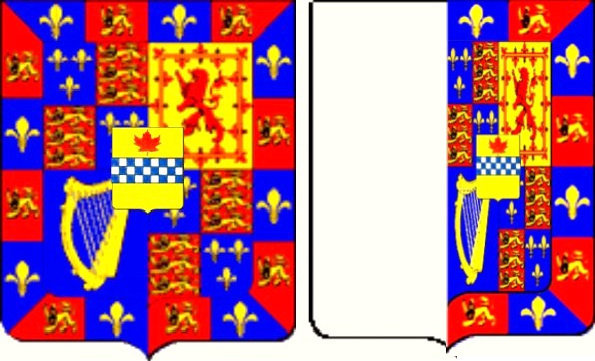
An excessively complicated Coat of Arms with a bordure compony: dimidiating the bordure for impalement at least eliminates four of the fleurs-de-lis and four of the lions, and creates some much-needed space for the artistic challenge of fitting all the remaining charges into just half of a shield. This is the reason behind the rule.
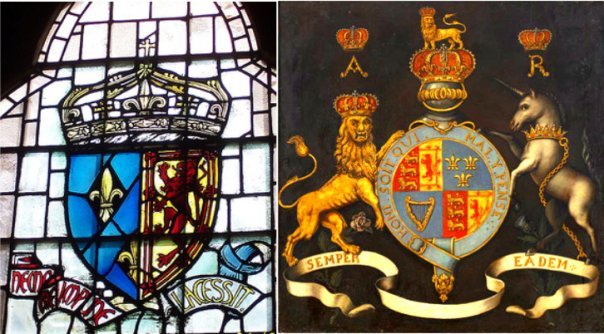
As Dauphine, Queen Consort and Queen Dowager of France, Queen Mary I of Scots impaled her Arms with those of her husband; I have been unable to find a single example of her marital Arms where Scotland's double tressure flory counter-flory has been dimidiated for impalement, even when the Coat of Arms of France itself is dimidiated, as illustrated above. After the Act of Union of 1707 Queen Anne granted the new Kingdom of Great Britain the Arms of England and Scotland impaled, and the royal tressure was thereafter always officially exemplified as dimidiated until, with the Act of Union of 1800, Scotland once again became a separate quarter of the royal Arms. The heralds of both Stuart queens were, of course, correct: there is no general "rule" but good heraldic taste.
I cobbled together the exemplification at the heading of this note to illustrate the elegance of my proposed impalement, and would further suggest to the Chief Herald that my proposal eliminates, by dimidiation, fifty percent of her originally-unwanted charge, and thus further moves her Arms toward the utmost simplicity of design.
To yet further encourage her, I would refer to the Coat of Arms of the University of Oxford's Balliol College, founded by John Balliol in about 1263. One of King Henry III of England's most loyal lords during the Barons' War of 1258 to 1265, he was married to a Scottish princess, Dervorguilla of Galloway; their son, also named John Balliol, was King of Scots from 1292 to 1296.
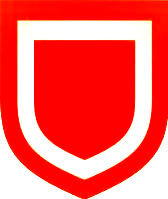
The Arms attributed to Balliol: Gules an orle Argent
The Scots heralds assigned King John Balliol a shield of Gules charged with an orle Argent, and from about 1600, this Coat was also used as the Arms of Balliol College. From about 1900, the College impaled these Arms with those of Dervorguilla of Galloway: Azure a lion rampant Argent crowned Or. According to the College's website, "Heraldic convention is that the arms of a man and his wife are normally impaled with his on the dexter side (left as viewed) and hers on the sinister side ... the impaling in the other way round proclaimed that her blood was bluer than his. She was a great grand-daughter of King David I of Scotland and it was through her that John Balliol her son claimed the throne of Scotland."
In Canada ladies are heraldically equal and identical to gentlemen, save for the unique Canadian system of brisures for differencing the Arms of daughters; and in Canadian law same-sex marriage has exactly the same legal status, and heraldic implications, as opposite-sex marriage. When contemplating an illustration of the marital impalement of their Arms, it is left to the two armigers in partnership to decide who is to be the dexter, and who the sinister.

The Arms used by Balliol College have never been authorized except by customary usage; they are taken from the impression on the back of the seal of Dervorguilla of Galloway, Lady of Balliol, which is attached to the Statutes she gave the College in 1282, and which survives intact.
The Letters Patent
The Letters Patent proclaiming Dr Boudreau's Grant of Arms, and the accompanying exemplification, are found in Volume IV, page 370, of The Public Register of Arms, Flags and Badges of Canada, dated April 15th, 2004.
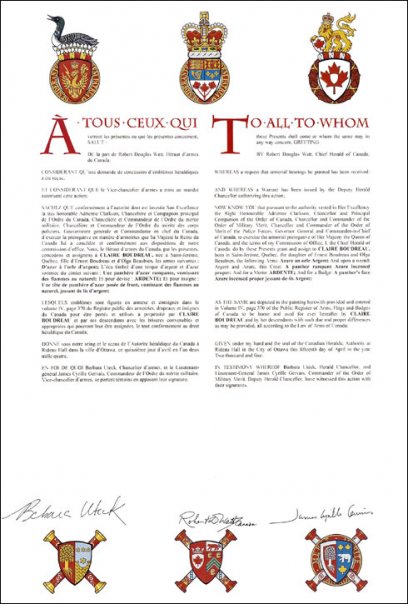
The Arms at the heading of the Letters Patent are those of: Her Excellency The Right Honourable Adrienne Clarkson PC CC CMM COM CD, Governor General; Her Majesty The Queen of Canada; and the Canadian Heraldic Authority. The signatures and Arms at the footing are those of: Barbara Uteck CVO, Herald Chancellor; Robert Watt LVO, Chief Herald; and Lieutenant-General James Gervais CMM CD, Deputy Herald Chancellor.
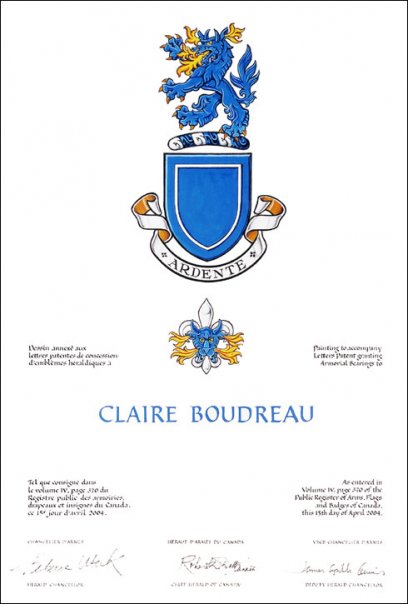
The artist is Gordon Macpherson, Niagara Herald Extraordinary, who was appointed a Member of the Order of Canada in 2008; the calligrapher is Nancy Ellis.
According to her own annotations, the field Azure of Dr Boudreau's Arms represents her French origins. "The narrow line (orle) appears as a second shield within the main shield and highlights both the importance of heraldry in her life and her doctoral research in this field. The orle and the overall simplicity of the design express both the absolute notion of the Cartesian 'whole', contained but continuous, and the idea that infinity can be contained within the span of one’s life or within any other given framework."
"The panther in the crest is a monster spewing fire from its mouth, nostrils and ears. It is the most appropriate symbol to express human passion in any domain. The heraldic panther is endowed with the body of a lion, a horse’s head with horns, a griffin’s forelegs and a lion’s hind legs. This diversified nature makes it a symbol of tolerance and of the spirit of adventure by which alone the frontiers of the unknown can be pushed back."
"ARDENTE ('fervent'), along with the panther in the crest is a reference to the totemic name 'Panthère ardente' ('Fiery panther') given to Claire Boudreau within the Scout movement in 1978. The motto therefore contains a second allusion to passion, a sort of internal flame that drives one to outstanding achievements."
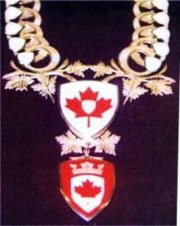
The Collar of Office of the Chief Herald of Canada, a Collar of C's
Heraldic Insignia of Office need not have a physical existence, but there is also, I am happy to say, a rarely-seen but tangible Baton of Office for Canada's Chief Herald.
With my congratulations to Saguenay Herald
and to Niagara Herald Extraordinary
for the honours received by them in 2008.
Happy New Year!
Brian de Fitz-James
